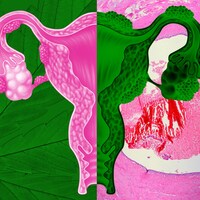After years of trying every cure imaginable, it took a diagnosis of PCOS (polycystic ovary syndrome) to finally treat one writer’s acne
According to the American Academy of Dermatology, more adult women have acne than ever before. When you’re a spotty teen, everyone tells you it’s just a phase, you’ll grow out of it. But instead of growing out of it, I grew into it. My acne never went away, it just changed. The non-inflammatory acne on my forehead and cheeks migrated down my face and sunk deeper into my skin. My forehead was clear and perfect, my chin was fine, but my jawline and neck—yes, neck—were like craters on the surface of the moon. I had full-blown cystic acne. “Cyst” is a universally unpleasant word (think: a Dr. Pimple Popper video). It conjures up memories of my skin at its worst, and reminds me of my ovaries, which—as I would eventually find out—have cysts of their own.
In the US, an estimated 5% of women have polycystic ovary syndrome (PCOS), a hormonal disorder considered to be one of the most common, but treatable causes of female infertility. PCOS is characterised by three primary symptoms: irregular periods, multiple cysts on one or both ovaries, and excess androgens. A PCOS diagnosis requires at least two of these symptoms—meaning you may be diagnosed with PCOS even if you don’t have actual cysts on your ovaries. The disorder is linked to obesity (present in at least 30% of PCOS patients) as well as insulin resistance and type 2 diabetes.
Androgens (testosterone, for example) are the steroid hormones involved in “male” sexual development and physique. In women, high androgen levels (hyperandrogenism) may present as excess hair on the face and body (hirsutism), thinning of hair on the scalp, and—you guessed it—acne.
According to the PCOS Awareness Association, over 10 million people suffer from PCOS worldwide, and half of them may not even know it. Many women aren’t diagnosed until they struggle with their fertility. Conversely, some women discover they have PCOS while looking for solutions to what feel like purely cosmetic complaints. This was the case for me.
“It was the revelation of cysts on my own ovaries that allowed me to finally clear the cysts on my face.”
It was the revelation of cysts on my own ovaries that allowed me to finally clear the cysts on my face. After so many years, treatments, and specialists, I never expected that an OB-GYN would be the answer to my beauty prayers. I was elated when my skin started to clear up. It was only later that I wondered, why didn’t anyone tell me about PCOS before?
Acne can make a sucker out of anyone, and for most of my life, that sucker was me. Acne is the great equalizer. Whoever you are, however rich or beautiful, young or old, acne can come for you and leave with your self-esteem. I was only fourteen when my innocent, rashy teen breakouts graduated to full-blown big “A” Acne. I felt the chaos of demonic jumping beans inside me, desperate to escape through the pores of my neck and jawline—a bucket of hormones being held hostage by a body in visible distress. For most of my life, I didn’t just have acne, I was acne. “Don’t let your pimples define you,” they said. But the truth is, my acne did define me. Obsessed with finding a solution, I tried antibiotics, chemical peels, prescription topicals, birth control, acupuncture, homoeopathy, herbal supplements, blue light treatments, cortisone injections, many derms and countless facialists. Nothing worked, or at least not for very long. Birth control made it worse. Antibiotics made it worse. Chemical peels made it better, but only for about a week. My decade of experiments left me feeling like I was immune to skincare.
Like me, many patients who are diagnosed with PCOS begin by seeing a dermatologist. This is probably because irregular periods seem like relatively less of a big deal than, say, acne, facial hair, or scalp hair loss. “Many times, patients come to see me after having tried many topical acne treatments and even prescription pills,” says Jessica Wu, M.D. (@drjessicawu), a Los Angeles dermatologist and author of Feed Your Face.
It’s crucial that dermatologists know what to look for when treating a new patient who may have PCOS. Irregular cycles, breakouts near your period, increased facial hair growth, or thinning hair on the scalp are some of the signs of hormonal acne and possibly PCOS. Dr. Wu also notes that cystic breakouts on the lower face are a typical hormonal pattern. Even if a patient’s breakouts are mild, “timing, location, and type of breakout are often a clue to hormonal acne.” Ideally, all of this should be discussed at your first appointment.
“Being diagnosed with PCOS felt like a relief. It provided a concrete answer to the question of why nothing could cure my acne.”
If Dr. Wu senses a hormonal component, she may either run blood tests or refer a patient to their gynaecologist for additional testing. Testing may consist of an ultrasound to look at a patient’s ovaries.
While there’s no cure for PCOS, there are treatments to help alleviate its symptoms. In the end, the only thing that cleared my skin was a drug called Spironolactone—the one thing I hadn’t heard of it until the day I started taking it. Traditionally, Spironolactone is used to treat high blood pressure and heart failure, but it also works to lower androgen levels. This makes it particularly helpful to patients suffering from persistent acne, hirsutism, and PCOS. Dr. Wu often prescribes it to female patients who have hormonal acne, but suggests that her patients with PCOS seek treatment from their gynaecologist. When taking the drug, it’s important to routinely check blood pressure and bloodwork.
I don’t know why the possibility of PCOS never occurred to any of the many dermatologists who saw me. Dr. Wu says that having treated teen and adult women with acne for over 20 years, she’s become much more aware of PCOS—diagnosing one or two of her acne patients with the disorder each year. “PCOS can affect reproductive health and fertility, so it’s important for all dermatologists to be on the lookout for possible hormonal imbalances.”
For me, being diagnosed with PCOS felt like a relief. It provided a concrete answer to the question of why nothing could cure my acne. What it means to me will most likely evolve over time. As my priorities shift—when I want to get pregnant—my PCOS will likely take on a new meaning. Until then, I’ll wake up every day and linger in front of the mirror a little bit longer than I have to. I’ll remember counting the number of fresh, active cysts to justify the cost of a trip to the dermatologist for injections. I’ll remember the feeling of that first cyst erupting after a chemical peel, or how I wouldn’t let my grandmother kiss my cheek in case her lipstick broke me out, or all the years I couldn’t wear a turtleneck—or god forbid, a scarf. I can’t promise that Spironolactone will change your life, but it definitely changed mine.




